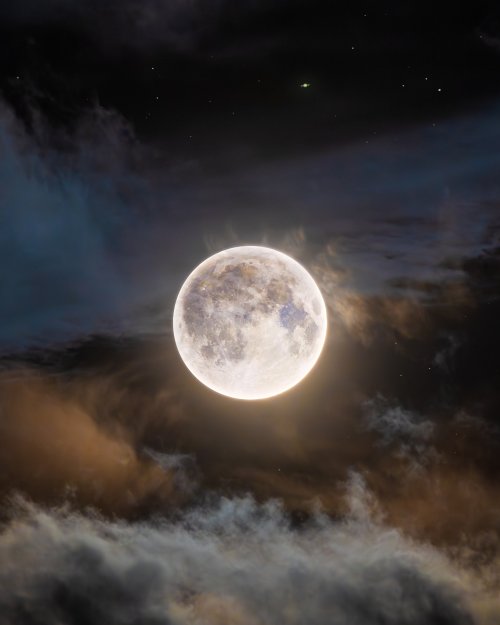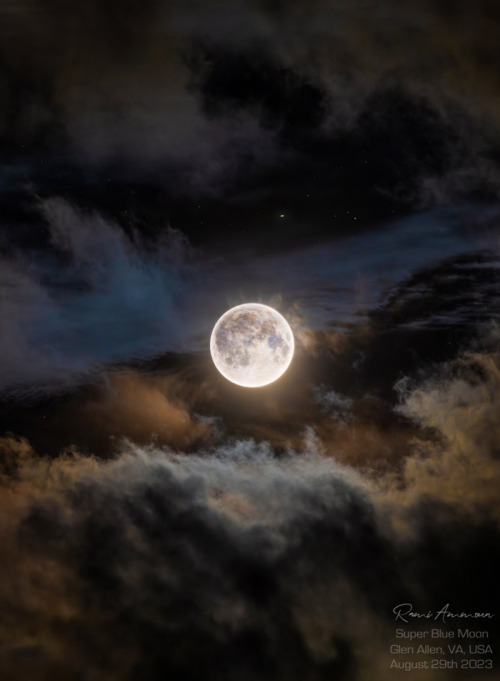What Did Hubble See On Your Birthday? (x)

What did Hubble see on your birthday? (x)
Dec. 3, 2009 - Stellar Jewel Box NGC 3603
More Posts from Ad-astra-affecte-spe and Others

Corona Australis
Nebula is mostly hydrogen gas, and a small amount of metals (elements above helium) which tend to be covered as "Dust", but it's the dust that best reflect the light of the stars, and as the largest and most energetic of them are blue, you get these areas of blue haze. Hydrogen more often glows red when bombarded by UV light, the two colours together quite magical.

The area has a number of NGC objects 6726,6727,6729 but born of the same huge molecular cloud.
Our Milky Way has many such areas full of star birth, and as blue giants are not long lived, supernova and star death too.



Cosmic Delights and Distant Discoveries Unfold in ‘Astronomy Photographer of the Year 15’

shit man this got me emotional
Y'all, the world is sleeping on what NASA just pulled off with Voyager 1
The probe has been sending gibberish science data back to Earth, and scientists feared it was just the probe finally dying. You know, after working for 50 GODDAMN YEARS and LEAVING THE GODDAMN SOLAR SYSTEM and STILL CHURNING OUT GODDAMN DATA.
So they analyzed the gibberish and realized that in it was a total readout of EVERYTHING ON THE PROBE. Data, the programming, hardware specs and status, everything. They realized that one of the chips was malfunctioning.
So what do you do when your probe is 22 Billion km away and needs a fix? Why, you just REPROGRAM THAT ENTIRE GODDAMN THING. Told it to avoid the bad chip, store the data elsewhere.
Sent the new code on April 18th. Got a response on April 20th - yeah, it's so far away that it took that long just to transmit.
And the probe is working again.
From a programmer's perspective, that may be the most fucking impressive thing I have ever heard.


With giant storms, powerful winds, auroras, and extreme temperature and pressure conditions, Jupiter has a lot going on. Now, NASA’s James Webb Space Telescope has captured new images of the planet. Webb’s Jupiter observations will give scientists even more clues to Jupiter’s inner life.
Credit: NASA, ESA, CSA, Jupiter ERS Team; image processing by Judy Schmidt. Read more

2023 September 28
The Deep Lagoon Image Credit & Copyright: Josep Drudis, Christian Sasse
Explanation: Ridges of glowing interstellar gas and dark dust clouds inhabit the turbulent, cosmic depths of the Lagoon Nebula. Also known as M8, The bright star forming region is about 5,000 light-years distant. It makes for a popular stop on telescopic tours of the constellation Sagittarius toward the center of our Milky Way Galaxy. Dominated by the telltale red emission of ionized hydrogen atoms recombining with stripped electrons, this deep telescopic view of the Lagoon’s central reaches is about 40 light-years across. The bright hourglass shape near the center of the frame is gas ionized and sculpted by energetic radiation and extreme stellar winds from a massive young star.
∞ Source: apod.nasa.gov/apod/ap230928.html



The 2nd full moon of August 2023 l Rami Ammoun


Comet Leonard

Going for a walk. Apollo 17 astronaut Ronald Evans leaves to the spacecraft to retrieve film cassettes from the Service Module, Dec 1972. Mr. Evans was Command Module Pilot & orbited the moon a record 75 times during the mission. He holds the record for most time spent in lunar orbit at just shy of 148 hours. He is the last human to orbit the moon solo. A historic figure in space pioneering.
-
 isadora-greenhall liked this · 2 months ago
isadora-greenhall liked this · 2 months ago -
 y2ksnowglobe reblogged this · 2 months ago
y2ksnowglobe reblogged this · 2 months ago -
 scorchedearthyearning reblogged this · 3 months ago
scorchedearthyearning reblogged this · 3 months ago -
 scorchedearthyearning liked this · 3 months ago
scorchedearthyearning liked this · 3 months ago -
 phantomravens reblogged this · 4 months ago
phantomravens reblogged this · 4 months ago -
 occams-machete reblogged this · 4 months ago
occams-machete reblogged this · 4 months ago -
 occams-machete liked this · 4 months ago
occams-machete liked this · 4 months ago -
 crackmonkeytrash liked this · 4 months ago
crackmonkeytrash liked this · 4 months ago -
 elusive-blu liked this · 4 months ago
elusive-blu liked this · 4 months ago -
 outer-space-and-chekov reblogged this · 4 months ago
outer-space-and-chekov reblogged this · 4 months ago -
 mr-ass-eater liked this · 5 months ago
mr-ass-eater liked this · 5 months ago -
 legendaryrunawaytyrant reblogged this · 6 months ago
legendaryrunawaytyrant reblogged this · 6 months ago -
 little-lesbian-lou reblogged this · 6 months ago
little-lesbian-lou reblogged this · 6 months ago -
 yellow0paint reblogged this · 6 months ago
yellow0paint reblogged this · 6 months ago -
 flamefirenut reblogged this · 7 months ago
flamefirenut reblogged this · 7 months ago -
 flamefirenut liked this · 7 months ago
flamefirenut liked this · 7 months ago -
 onefleshonepod reblogged this · 7 months ago
onefleshonepod reblogged this · 7 months ago -
 blurbitch liked this · 8 months ago
blurbitch liked this · 8 months ago -
 lebnameanssoul liked this · 9 months ago
lebnameanssoul liked this · 9 months ago -
 slutmaxxing reblogged this · 10 months ago
slutmaxxing reblogged this · 10 months ago -
 an-angels-fury liked this · 10 months ago
an-angels-fury liked this · 10 months ago -
 lilihopeless liked this · 11 months ago
lilihopeless liked this · 11 months ago -
 fishmech reblogged this · 11 months ago
fishmech reblogged this · 11 months ago -
 fishmech liked this · 11 months ago
fishmech liked this · 11 months ago -
 idreaminpixels liked this · 11 months ago
idreaminpixels liked this · 11 months ago -
 truenoodle reblogged this · 11 months ago
truenoodle reblogged this · 11 months ago -
 whattanerd liked this · 1 year ago
whattanerd liked this · 1 year ago -
 stellarskyes reblogged this · 1 year ago
stellarskyes reblogged this · 1 year ago -
 carnalcommunion reblogged this · 1 year ago
carnalcommunion reblogged this · 1 year ago -
 meteoriteskies reblogged this · 1 year ago
meteoriteskies reblogged this · 1 year ago -
 lovelydulcecito reblogged this · 1 year ago
lovelydulcecito reblogged this · 1 year ago -
 shotofstress reblogged this · 1 year ago
shotofstress reblogged this · 1 year ago -
 alexissrose reblogged this · 1 year ago
alexissrose reblogged this · 1 year ago -
 toonfan2106 liked this · 1 year ago
toonfan2106 liked this · 1 year ago -
 dreamingangell reblogged this · 1 year ago
dreamingangell reblogged this · 1 year ago -
 kapturkaptur liked this · 1 year ago
kapturkaptur liked this · 1 year ago -
 disneydreamer07 liked this · 1 year ago
disneydreamer07 liked this · 1 year ago -
 slowest-slow-cooker reblogged this · 1 year ago
slowest-slow-cooker reblogged this · 1 year ago -
 epicuross liked this · 1 year ago
epicuross liked this · 1 year ago -
 slowest-slow-cooker liked this · 1 year ago
slowest-slow-cooker liked this · 1 year ago -
 potofbees reblogged this · 1 year ago
potofbees reblogged this · 1 year ago -
 afreakingnature reblogged this · 1 year ago
afreakingnature reblogged this · 1 year ago -
 afreakingnature liked this · 1 year ago
afreakingnature liked this · 1 year ago -
 tvversionperson liked this · 1 year ago
tvversionperson liked this · 1 year ago -
 magical-girl-04 liked this · 1 year ago
magical-girl-04 liked this · 1 year ago -
 hooooooooman reblogged this · 1 year ago
hooooooooman reblogged this · 1 year ago -
 hooooooooman liked this · 1 year ago
hooooooooman liked this · 1 year ago -
 spark-is-tired reblogged this · 1 year ago
spark-is-tired reblogged this · 1 year ago

★•Astronomy, Physics, and Aerospace•★ Original and Reblogged Content curated by a NASA Solar System Ambassador
204 posts
